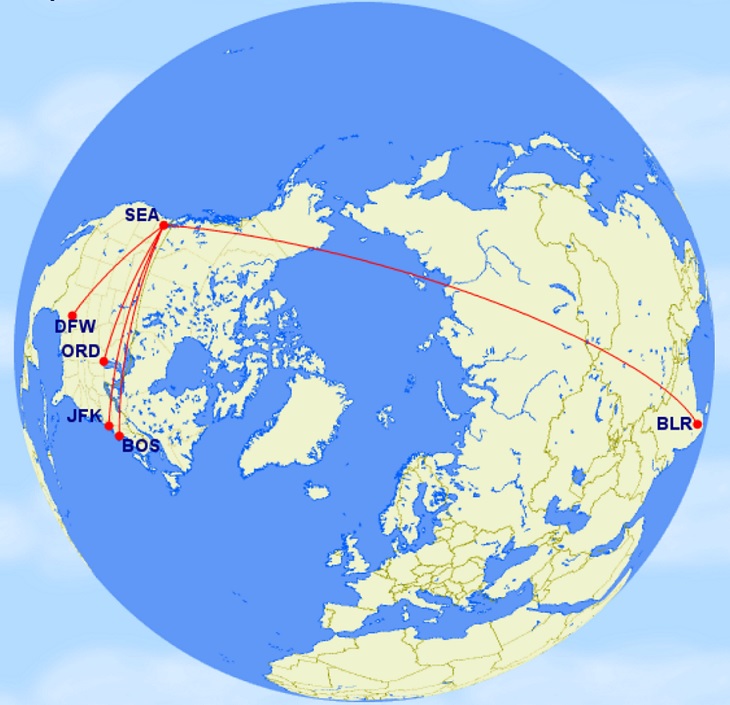In mid-February, just as the coronavirus pandemic was gaining steam, American Airlines announced a partnership with Alaska Airlines and plans to serve Seattle – Bangalore, India. It was to be American’s return to India, and the first U.S.-Bangalore non-stop.
The flight’s launch as been delayed to next year, but American Airlines President Robert Isom told his airline’s pilots last week that they’re still committed to it – even though United Airlines has just announced plans to fly San Francisco – Bangalore and will likely pick up most of the non-stop tech corridor business, and they’re planning to launch their flight before American begins its service.
Isom said he doesn’t regret the announcement, tipping their hand to United, because “the lead time is long to get markets like that set up, so you can’t be too stealthy…we anticipated that others would try to get in.”
And American’s strategy is different from United, noting that “Seattle is a fantastic point in which to really connect with that part of the world..in all likelihood we’ll be able to fly with higher loads…Seattle can connect for most of the country in a non-circuitous way..and we have this partnership with Alaska and they have a fully developed very large connecting hub.”
San Francisco is the largest market to Bangalore by far (17%), followed by New York, Chicago, Dallas and Boston. Seattle is only the 8th largest U.S.-Bangalore non-stop market with 4.3% of the traffic. United’s flight should pick up most of the non-stop business from the Bay Area, except for Alaska Airlines loyalists in the area. American’s play is for connecting traffic.

That’s not to say that United won’t have connecting traffic on its Bangalore flights. They have a well developed hub at San Francisco. But they’ll be able to focus more on premium non-stop business from the tech corridor, which no doubt American had hoped to pick up before United’s announcement.
Meanwhile Senior Vice President Vasu Raja doubled down, “we’re absolutely committed to the Seattle hub and our partnership with Alaska.” American calls its close partner hubs their own hubs as well, like they consider London Heathrow to be a hub because of their joint venture with British Airways – and New York JFK should again become a true hub given their new partnership with JetBlue that’s coming online.
Raja emphasizes that making the flight work means driving the integration with Alaska Airlines, because “in order to make those services work it needs to be that a customer of either Alaska or American Airlines would choose us over one of our competitors’ long haul services” because of upgrades, seat assignments, and other benefits.


SFO and SEA are essentially the same in terms of connections. So, if you’re not starting in one of those cities, it’s a wash.
Obviously the Bay Area traffic will be significantly more lucrative than the Seattle area.
Wonder if United will offer global WiFi on that flight. Imagine it will test the limits of satellites
You may need to update your thoughts on where the lucrative tech corridor is , with Seattle home to the two largest tech companies Amazon and Microsoft, Facebook and Google largest engineering office outside of Silicon Valley , Salesforce second HQ , this is going to be an extremely strong market for SEA- BLR
@Tripee – the SFO market is several times the size of SEA for BLR travel, even if Seattle grows
Will BLR sustain 2 daily flights to US west coast…? It will…seeing the demand and high yields (pre covid)
And don’t forget UA partners with Air India and Vistara to feed domestic traffic in India. I am not sure how will AA manage that
In spite of AA’s kind words towards Alaska Air, this cannot be intended to be all connecting traffic. AA has to be planning on getting a pretty large number of O&D customers in Seattle, or else they’d just fly the route from O’Hare.
SFO-BLR would have been very successful pre-covid, but both of these flights will inevitably fail once it is realized that business travel will not return for several years.
It’s too bad that BLR has surpassed the bigger city Chennai which is the gateway to the south. A city that has a big industrial base as well as many IT companies. The privatization of BLR is a big reason. MAA is controlled by the government and it doesn’t care to get more flights like BLR
Do you work for AA? Why doesn’t the map also show UA’s connecting cities through SFO?
And, of course, if you are traveling from NYC/CHI/DFW/BOS and are more than half-witted you will choose Cathay or ANA or JAL or Singapore Airlines etc. over American or United, even if they cost more.
I hope BLR gets direct connectivity to NYC instead of two daily direct flights to west coast.
As a frequent flier to Chennai (MAA) one of the large cities in India (bigger than BLR) I would never fly to BLR and then take a connection to Chennai. Connecting within India can be a big headache. I would much rather take Emirates to DXB and connect to MAA. From SFO you have Cathay Pacific, Qatar, Singapore Airlines and you have excellent connections to many larger Indian cities.
Maine has that much demand?